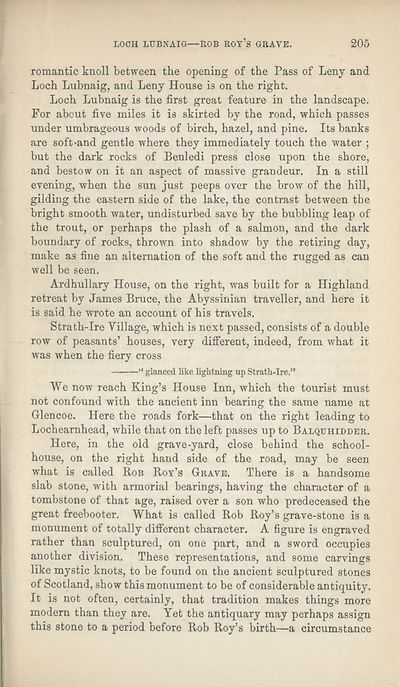Download files
Complete book:
Individual page:
Thumbnail gallery: Grid view | List view

LOCH LTJBNAI6—ROB ROT’S GRAVE.
205
romantic knoll between the opening of the Pass of Lenj and
Loch Lubnaig, and Leny House is on the right.
Loch Lubnaig is the first great feature in the landscape.
For about five miles it is skirted by the road, which passes
under umbrageous woods of birch, hazel, and pine. Its banks
are soft-and gentle where they immediately touch the water ;
but the dark rocks of Benledi press close upon the shore,
and bestow on it an aspect of massive grandeur. In a still
evening, when the sun just peeps over the brow of the hill,
gilding the eastern side of the lake, the contrast between the
bright smooth water, undisturbed save by the bubbling leap of
the trout, or perhaps the plash of a salmon, and the dark
boundary of rocks, thrown into shadow by the retiring day,
make as fine an alternation of the soft and the rugged as can
well be seen.
Ardhullary House, on the right, was built for a Highland
retreat by James Bruce, the Abyssinian traveller, and here it
is said he wrote an account of his travels.
Strath-Ire Village, which is next passed, consists of a double
row of peasants’ houses, very different, indeed, from what it
was when the fiery cross
“ glanced like lightning up Strath-Ire.”
We now reach King’s House Inn, which the tourist must
not confound with the ancient inn bearing the same name at
Glencoe. Here the roads fork—that on the right leading to
Lochearnhead, while that on the left passes up to Balquhidder.
Here, in the old grave-yard, close behind the school-
house, on the right hand side of the road, may be seen
what is called Rob Roy’s Grave. There is a handsome
slab stone, with armorial bearings, having the character of a
tombstone of that age, raised over a son who predeceased the
great freebooter. What is called Rob Roy’s grave-stone is a
monument of totally different character. A figure is engraved
rather than sculptured, on one part, and a sword occupies
another division. These representations, and some carvings
like mystic knots, to be found on the ancient sculptured stones
of Scotland, show this monument to be of considerable antiquity.
It is not often, certainly, that tradition makes things more
modem than they are. Yet the antiquary may perhaps assign
this stone to a period before Rob Roy’s birth—a circumstance
205
romantic knoll between the opening of the Pass of Lenj and
Loch Lubnaig, and Leny House is on the right.
Loch Lubnaig is the first great feature in the landscape.
For about five miles it is skirted by the road, which passes
under umbrageous woods of birch, hazel, and pine. Its banks
are soft-and gentle where they immediately touch the water ;
but the dark rocks of Benledi press close upon the shore,
and bestow on it an aspect of massive grandeur. In a still
evening, when the sun just peeps over the brow of the hill,
gilding the eastern side of the lake, the contrast between the
bright smooth water, undisturbed save by the bubbling leap of
the trout, or perhaps the plash of a salmon, and the dark
boundary of rocks, thrown into shadow by the retiring day,
make as fine an alternation of the soft and the rugged as can
well be seen.
Ardhullary House, on the right, was built for a Highland
retreat by James Bruce, the Abyssinian traveller, and here it
is said he wrote an account of his travels.
Strath-Ire Village, which is next passed, consists of a double
row of peasants’ houses, very different, indeed, from what it
was when the fiery cross
“ glanced like lightning up Strath-Ire.”
We now reach King’s House Inn, which the tourist must
not confound with the ancient inn bearing the same name at
Glencoe. Here the roads fork—that on the right leading to
Lochearnhead, while that on the left passes up to Balquhidder.
Here, in the old grave-yard, close behind the school-
house, on the right hand side of the road, may be seen
what is called Rob Roy’s Grave. There is a handsome
slab stone, with armorial bearings, having the character of a
tombstone of that age, raised over a son who predeceased the
great freebooter. What is called Rob Roy’s grave-stone is a
monument of totally different character. A figure is engraved
rather than sculptured, on one part, and a sword occupies
another division. These representations, and some carvings
like mystic knots, to be found on the ancient sculptured stones
of Scotland, show this monument to be of considerable antiquity.
It is not often, certainly, that tradition makes things more
modem than they are. Yet the antiquary may perhaps assign
this stone to a period before Rob Roy’s birth—a circumstance
Set display mode to:
![]() Universal Viewer |
Universal Viewer | ![]() Mirador |
Large image | Transcription
Mirador |
Large image | Transcription
| Antiquarian books of Scotland > Scotland/Scots > Black's picturesque tourist of Scotland > (285) |
|---|
| Permanent URL | https://digital.nls.uk/130031610 |
|---|
| Description | Thousands of printed books from the Antiquarian Books of Scotland collection which dates from 1641 to the 1980s. The collection consists of 14,800 books which were published in Scotland or have a Scottish connection, e.g. through the author, printer or owner. Subjects covered include sport, education, diseases, adventure, occupations, Jacobites, politics and religion. Among the 29 languages represented are English, Gaelic, Italian, French, Russian and Swedish. |
|---|

